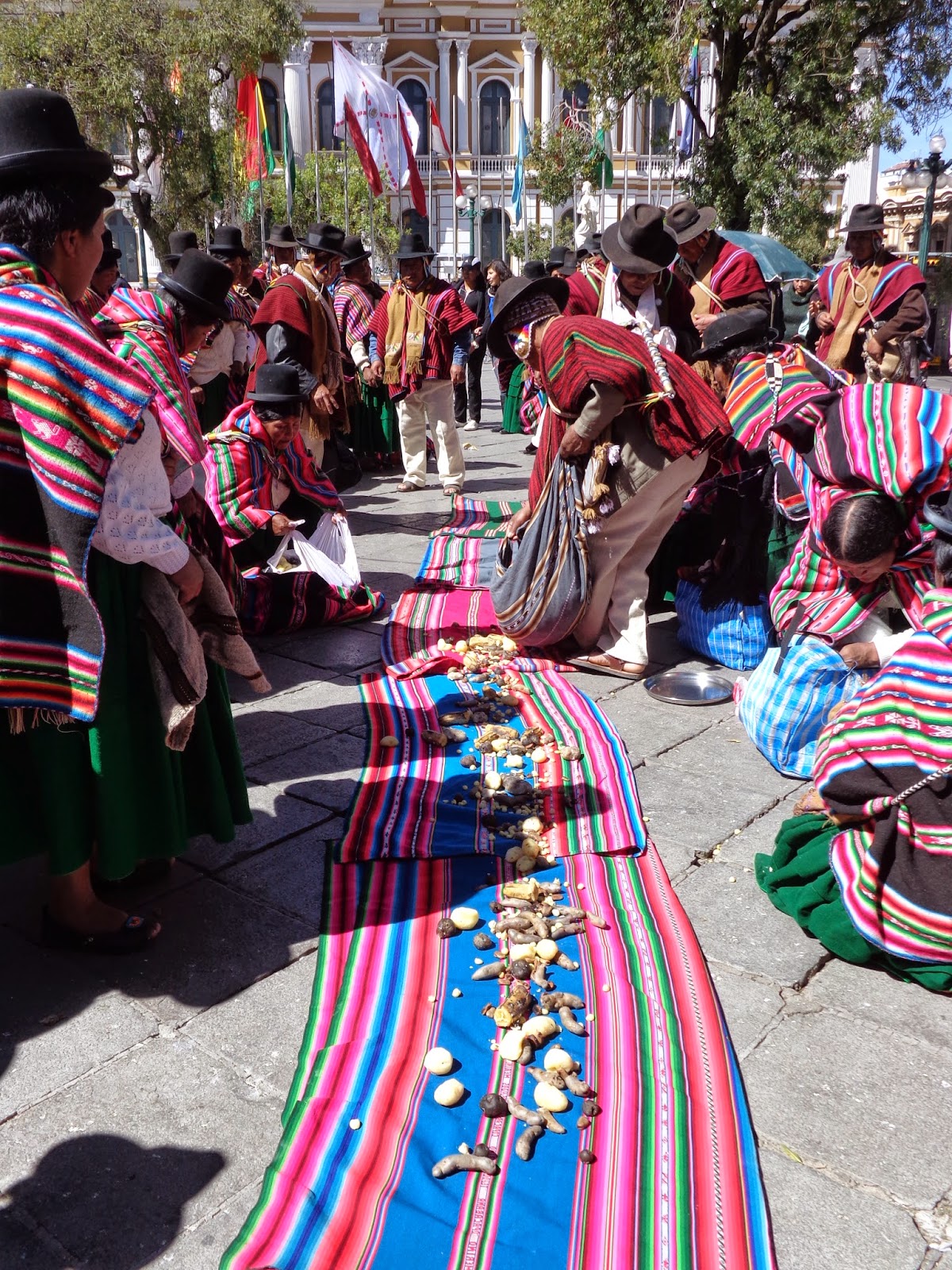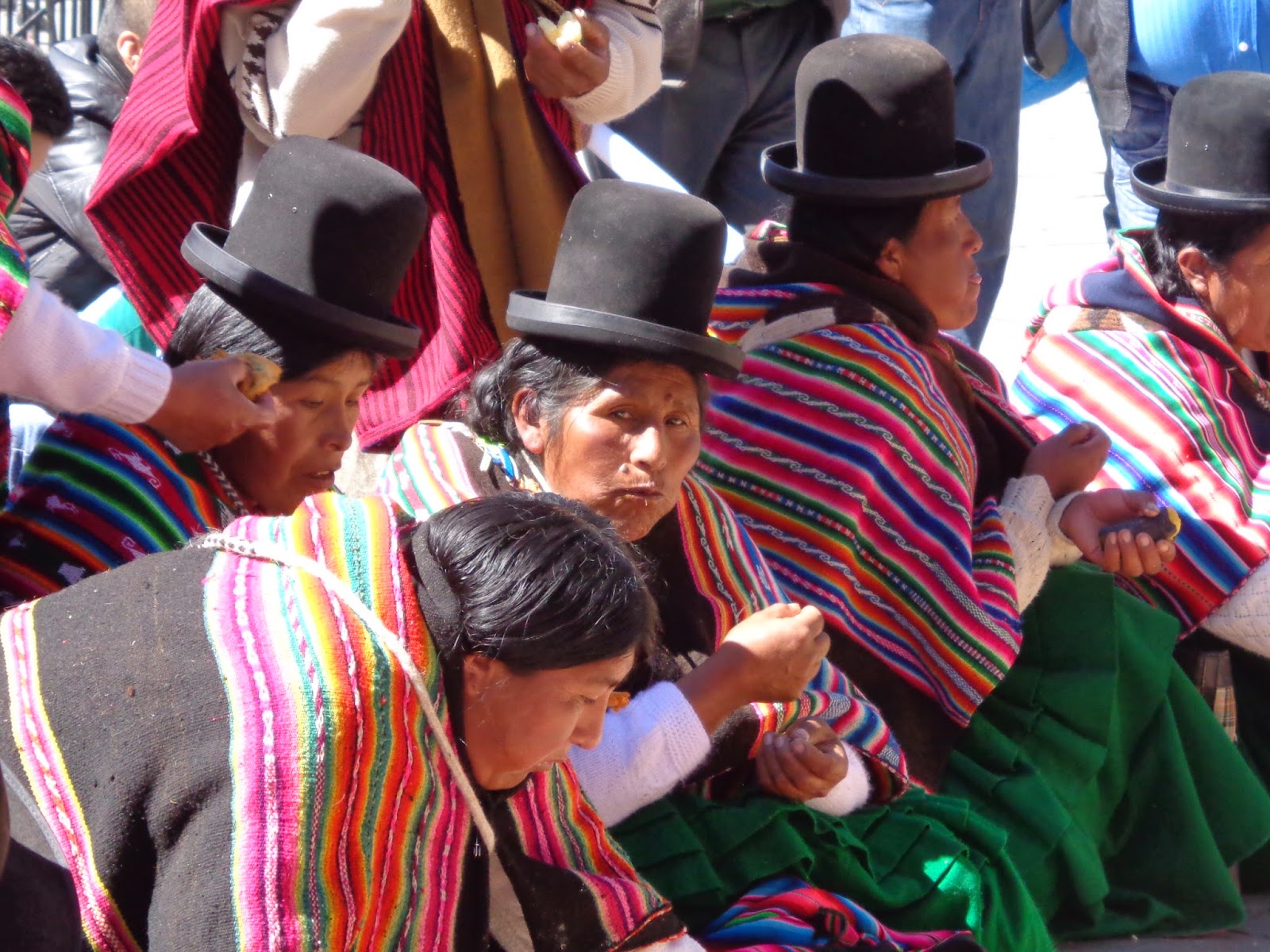Today is the first day on the Andean calendar. Here is a mighty celebration by the Tiuanacu outside Bolivia's government buildings. For a city that has so often reminded me of others (Belfast, New York, Paris, Rio de Janeiro) it still reserves a character so unique that you marvel in it.
There were many tourists taking photos of these folk in traditional dress.Not all had the stones to go wandering amongst them and eat, too.
The flag with the squares is the Aymara flag. The middle one is Bolivia's national flag. The white one... not sure. I'm guessing another native peoples'.
That´s an enormous blanket covered in potatoes. All for sharing.
This chap insisted I help myself to even more potatoes (admittedly cold, but still, free potatoes grown a few miles away!) and cheese. The cheese was just about as good as I've ever had in my life. He explained that it was the start of the new year according to the Andean Calendar and that they were from Tiuanacu. He also explained that the pink that you see everyone wearing is the colour of authority in their community. Its little facts like that that are hard to come by.
This chap gave Sarah a great big smile and insisted she also get in on the potato-eating activities. She had a big golden one and took her time with it. In this instance I totally understand why. Cold potatoes are an acquired taste.
This red poncho is the traditional dress for men in this part of the altiplano. When President Morales made his way into power in 2006 and the big social changes started you would find everyone wearing it, from the President and the military leaders right the way through society.
Coca leaves. "Not white" as President Morales pointed out the UN, a former coca grower himself whose popularity is often explained as that he is the first Bolivian president who can speak Aymara. The chap we spoke to taught us the first three numbers in Aymara, not how we expected to spend this morning, but brilliant all the same. I have been searching for a better Español - Aymara dictionary but they are surprisingly harder to find here than in Peru.
Best coca leaves I've had yet. Really fresh and delicious.
These coloured sheets are used to carry everything from bread to babies. You can buy them almost everywhere and they're extremely durable.
After all that excitement, as we waiting for Thursday to draw in on us, we had little to do but a little shopping. We downed a tasty coffee in Cafe Copacabana (accompanying Rollo de Canela, or cinnamon roll, was warm and delicious! Oh how I have missed cinnamon!) and stepped forth on what promised to be one of our final gift-hunting days. Up and down the streets of Old La Paz we went, in and out of little outlets, until finally we had another bag or two of pruck and we felt capable of sitting down and inhaling some meat. This is how The Steakhouse (just next door to The English Pub) serves up a llama steak. First one of the trip. Well seasoned though just a little overdone for me. Mind you, best salad bar in South America so can't complain too much.
Now, however, its time to live like children as we distract ourselves from the imprending maelstrom of visa hell. Around the bridge leading from San Francisco's church there are a lot of ladies with stalls selling sticker albums. World Cup Sticker Albums. Official Ones By Panini. This may have been Sarah's idea. According to her she has never had a sticker album. I cannot believe it. Even I, who showed no interest in football most of my entire life, used to collect stickers for the world cup. It must be done. It can be done.
Its done. The albums are about 80p each. We bought a box of stickers, 100 packets, for about GBP20. We bought a bottle of wine in Cafe Torino for BOB50 (about GBP4.15) and we spent nearly four hours totally absorbed in this.
Oh, and we spent a quid on the way back for a portion of salchipapas too. Sarah had burned through her 50 packets, whilst I had only done half of mine, and I needed something to distract her. Chips and hot dogs were the answer, hahah!


















































No comments:
Post a Comment